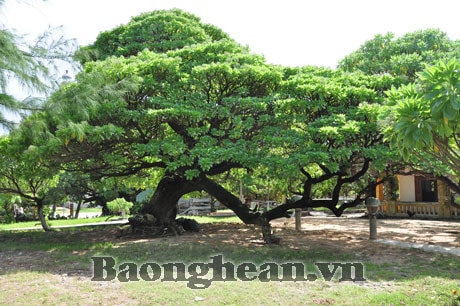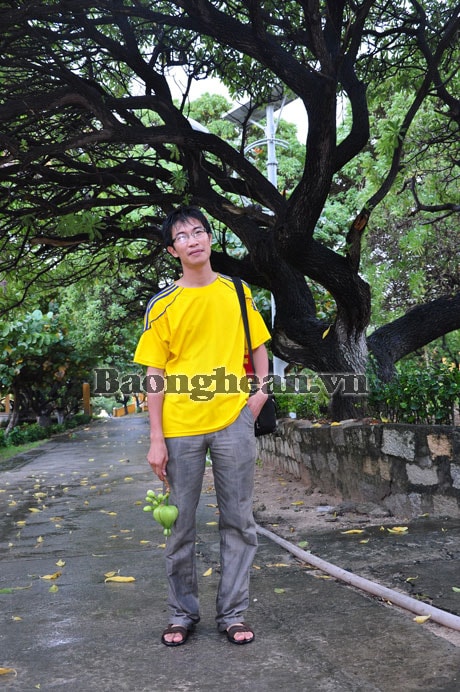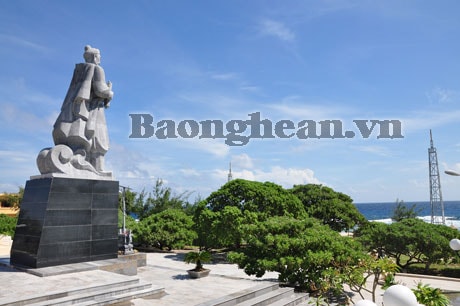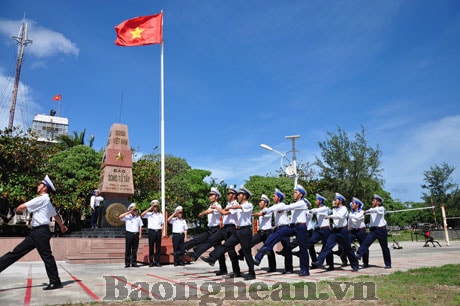Lesson 3: Statue of Saint Tran and the maple tree in the middle of the ocean
The Phong Ba tree is everywhere on Song Tu Tay Island; there are many old trees and many young trees. Phong Ba is a small plant with a soft, curved trunk, only 3-6m high on average, low branches, and strong vitality. The tree takes root on the coral and sand, resists storms and salt water, diligently grows branches, blooms, covers the wind, and fixes the sand... Perhaps with these characteristics, the Phong Ba tree has, along with the storms and the Banyan tree, become a symbol of the indomitable and resilient Truong Sa, standing firm day and night on the front line.

Ancient tree on the island
At this time, spring has come to the easternmost land of the Fatherland; along with the vibrant atmosphere of the harmony of the earth, sky and sea, storms are also budding and blossoming. In the strong winter wind, the young, tender leaves flutter, strangely familiar and dear; the tree bark is rough, discolored by the wind and rain, but full of the green color of life. Many trees were broken by storms from the previous days, but from the wounds, new shoots have grown and developed. The tree branches stretch out as if embracing the ground. On Song Tu Tay Island, Phong Ba trees have a very beautiful canopy shape, so the cadres, soldiers and islanders have planted them in rows to provide shade, creating a green, clean and beautiful landscape.

Nghe An Newspaper reporter on Song Tu Tay island
Leading us to visit the green island, Lieutenant Colonel Vu Van Cuong, Commander of Song Tu Tay Island, said: Phong ba is a very slow-growing tree, the tree matures after 10 years, only 3-4m high. The tree can regenerate by seeds and shoots, in reality, natural regeneration only occurs on islands, and almost never occurs in coastal areas. The green Phong ba tree roots not only contribute to increasing the beauty of the unit's environmental landscape but also help each officer and soldier in the unit always be aware of the task of contributing to the protection and construction of the sacred islands of the Fatherland. The planting, propagation and protection of shade trees, fruit trees and green vegetables has become a widespread movement and a self-consciousness of the army and people of Truong Sa Island District. Every year, soldiers stationed on the islands have coordinated with local households to actively plant trees, from timber trees and fruit trees brought from the mainland to hardy species such as the Phong Ba, Chua Ca, Nuoc Ma, and Banyan Tree. Thanks to that, the islands are increasingly green and cool.

Statue of King Tran Quoc Tuan on Song Tu Tay Island.
On the east side of Song Tu Tay Island, next to the rows of phong ba trees, is the newly erected statue of the National Duke, Commander-in-Chief Hung Dao Dai Vuong Tran Quoc Tuan. The statue of the national guardian saint, one of the great generals in human history, faces the ocean, majestic and imposing, strangely in harmony with the phong ba trees. The statue is made of Ninh Binh green stone, 11 meters high, weighs about 30 tons, and is placed in an area of over 600 square meters. This work was carved according to the model in the March 2nd Square in Nam Dinh City, with a cost of 6.5 billion VND, and is a gift from Nam Dinh province to Truong Sa. Along with the Chu Dau ceramic statue placed on Truong Sa Lon Island, the statue of Saint Tran at Song Tu Tay was inaugurated in May 2012...
The statue depicts a national hero who defeated the Yuan-Mongol invaders three times, dressed in a turban and cloth shirt, holding the Proclamation of the General in his right hand and resting his left hand on the hilt of his sword. The statue's natural and simple demeanor exudes the spirit of a Vietnamese general, both literary and martial, humane... Lieutenant Colonel Nguyen Trong Binh, Political Commissar of Song Tu Tay Island, shared his appreciation: "The statue represents the spirit of the Vietnamese people that our people love peace, never want war, never initiate war. We also firmly believe that we will never have to draw our swords, but we are always vigilant and ready to fight the invaders. The statue placed in Truong Sa has great significance for the sovereignty of the sea and islands. During every holiday, the army and people on the island still come to the monument to worship, make pilgrimages and remind each other of that spirit...".

Soldiers practice and review the formation.
The waves of the East Sea remind us of the Bach Dang River. In the vastness of the sea and sky, we can still hear the echoes of the words passed down to the descendants of King Tran Quoc Tuan: “Chung chi thanh Thanh” – that is, the solidarity of all the people is the wall to protect the country; promoting the will and patriotism of the people will create the most solid wall to protect the Fatherland. Today’s descendants in Truong Sa and the mainland are imbued with this teaching.
During my recent trip to Quynh Luu district, I heard Mr. Bui Thai Linh, Chairman of the Quynh Phuong Commune Fisheries Association, say these heartfelt and responsible words: "Every Vietnamese fisherman today is always aware that every boat going out to sea today is a national border marker at sea."
And today, at the Song Tu Tay Island Sovereignty Marker, under the glorious National Flag, we heard the 10 faithful oaths of the soldiers defending the island as if carved into the land, sky, and waves of Truong Sa: “Sacrifice everything for the Fatherland of Vietnam. Under the leadership of the Communist Party of Vietnam, strive to build a peaceful, independent, socialist Vietnam… No matter how hard or difficult, we will not be discouraged, no matter how much life or death we face. We will complete every mission, overcome every difficulty, and defeat every enemy… I swear! I swear! I swear!”… We also had the opportunity to listen to the poem of the island soldier Nguyen Van An about the Tran Quoc Tuan monument. The poem says, “Standing tall and proud in a corner of the sky/ Saint Tran Hung Dao in the middle of the ocean/ The Essentials of Military Strategy passed down to his descendants/ The king and his subjects united in one heart/ / The elders of Dien Hong said in unison, “Fight”/ Bach Dang buried the bodies of the invaders/ The Mongols were terrified and defeated three times/ Dai Viet remained intact for a thousand years/ Saint Tran Hung Dao on Song Tu/ The majestic virtue of the Saint ruled the Southern sky/ Protected the army and people to guard the island/ Chased the enemy to the East Sea”.
"One inch of map, ten thousand inches of homeland...", at this time, all Vietnamese people have, in one way or another, expressed their love for the country and cherished every inch of their homeland. As for scholars, they have their own way of providing clear evidence that the two archipelagos of Hoang Sa and Truong Sa belong to Vietnam: Dr. Mai Hong presented to the State the map "Hoang Trieu Truc Tinh Dia Du Toan Do" published by Shanghai Publishing House in 1904, at the end of the Qing Dynasty, which did not include the two archipelagos of Hoang Sa and Truong Sa; Mr. Tran Thang, President of the Institute of Vietnamese Cultural Education in the United States, collected and published 7 other maps published by Western countries from the late 19th century to the early 20th century, all of which drew Chinese territory limited to Hainan Island, and two maps depicting Vietnamese territory with images of the Hoang Sa and Truong Sa archipelagos published in Europe since 1736; The Dang family in Ly Son island district, Quang Ngai has presented to the State valuable documents such as maps, royal decrees, and royal notes of the Nguyen Dynasty Kings, which have historical and cultural values related to Vietnam's sovereignty over the Hoang Sa and Truong Sa archipelagos... |
Article: Thanh Chung; Photo: Minh Thong (Email from Song Tu Tay Island)






